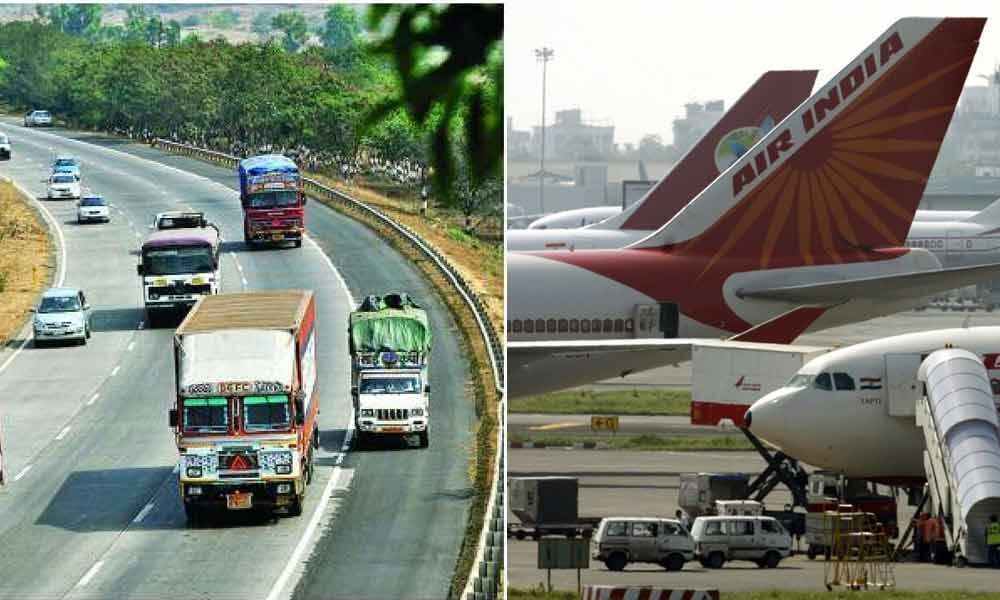Live
- Nizamabad MP Dharmapuri Arvind and Jagtial MLA Dr. Sanjay Kumar Meet CM Revanth Reddy
- Hyderabad CP CV Anand Issues Stern Warning to Bouncers
- MP Laxman Criticizes Police Conduct, Calls for Support for Victims' Families
- Fire Breaks Out in Kachiguda-Chennai Egmore Express, Passengers Evacuated Safely
- CM Revanth Reddy Condemns Attacks on Film Personalities' Homes, Calls for Strict Action
- Victory Venkatesh and Nandamuri Balakrishna to Set Screens on Fire with Unstoppable Season 4
- Over 71.81 crore Ayushman Bharat Health Account numbers generated: Centre
- In special gesture, Kuwait's Prime Minister sees-off PM Modi at airport after conclusion of historic visit
- Veer crowned PGTI Ranking champion, Shaurya wins emerging player honour
- Sr National Badminton: Unseeded Rounak Chauhan, Adarshini Shri reach singles semis
Just In

India needs to expedite infrastructure development, boost economic growth and create jobs
It is crucial for the government to keep pushing towards more effective growth-oriented policy framing and implementation in India.
The focus must be on creating both 'hard' and 'soft' infrastructure while facilitating effective debt usage.
Hard infrastructure must see a continuation of the progress seen in areas such as highway construction and the gradual increase in participation of deep-pocketed institutional investors in owning assets.
Soft infrastructure pertains to assets that help create demand for hard infrastructure assets.
Airline businesses would be an example of soft infrastructure that is so essential for robust demand for airport assets. Ensuring that both hard and soft infrastructure asset creation pick up further pace is vital.
The need to push along with creating new hard infrastructure assets such as airports, highways, energy generation & distribution etc. is evident given the trend of higher consumption.
The critical aspect that needs to be kept in mind is a "sustainable" path of creation is much more likely to deliver long-term benefits than a rapid approach with pitfalls along the way.
In layman's terms, effective project planning, efficient project implementation and prudent usage of debt funding in the hard infrastructure creation process will be of vital importance.
In the recent past, active participation by capital-rich large institutional investors in the highways and renewable energy sector in India shows the demand for such assets.
That said, the two Toll-Operate-Transfer (TOT) highway auctions by the National Highways Authority of India (NHAI) are symbolic that investors will be aware of both asset price and quality.
While the first TOT auction saw a winning bid that was much higher than expected, the second auction had to be cancelled since the highest bid wasn't where the NHAI expected the bid price to be.
The key takeaway is that investors would be discerning regarding asset quality and pricing. The government must make sure that the investment momentum sustains while learning a few lessons from the TOT auctions.
Creating soft infrastructure is as important as creating hard infrastructure. Soft infrastructure are assets that perhaps do not fit the traditional definition of infrastructure assets but are essential pillars of economic growth, primarily as soft infrastructure such as airlines create demand for hard infrastructure assets such as airports.
The recent turmoil in the airline sector further emphasises the need to create policies that help boost the sector. While it is true that any industry is subject to the travails of the business cycle, and this is especially true for airline businesses, it is also essential that all steps from a policy perspective are taken to ensure that the sector can thrive.
A vibrant airline sector translates into greater usage for airport assets, thereby boosting the demand for airport infrastructure. Higher demand for airport infrastructure from the investment community can hopefully translate into a robust infrastructure creation pipeline for the sector.
One of the crucial linkages between efficient creation and operation of both hard and soft infrastructure is optimal debt usage.
It is important to note that debt in itself is only as good as its usage, implying that prudent use of debt for businesses delivers value for the ecosystem. On the contrary, excessive debt usage, especially for businesses unsuitable for debt usage can lead to results that aren't suitable.
The assertion that "capital structure risk must be inversely proportional to business risk" is one that merits attention. The statement mentioned above implies that debt is more useful for businesses that have access to steady cash flows as opposed to companies that have higher variability of cash flows.
So, in general, a utility business would be more suitable for debt usage than say a retail business. The caveat is that cash flow mismatches must be avoided. For instance, excessive debt servicing costs during production ramp-up periods when incoming cashflows for a utility business are low can render even suitable projects unviable.
Therefore, debt usage within the context of both the cashflow profile of the industry and cashflow matching is an essential cog in the wheel to ensure economic expansion. Measures such as effective bankruptcy regulations and prudent lending that ensure better debt usage must be encouraged even further.
The linkage between hard infrastructure, soft infrastructure and optimal debt usage is an essential one especially in the context of India's need to expedite infrastructure creation, boost economic growth and create jobs. A renewed focus on infrastructure building and the linkages is the need of the hour.
Taponeel Mukherjee

© 2024 Hyderabad Media House Limited/The Hans India. All rights reserved. Powered by hocalwire.com







